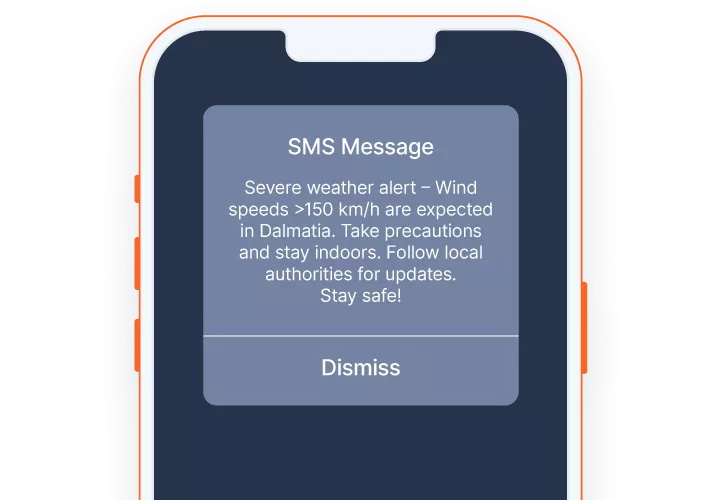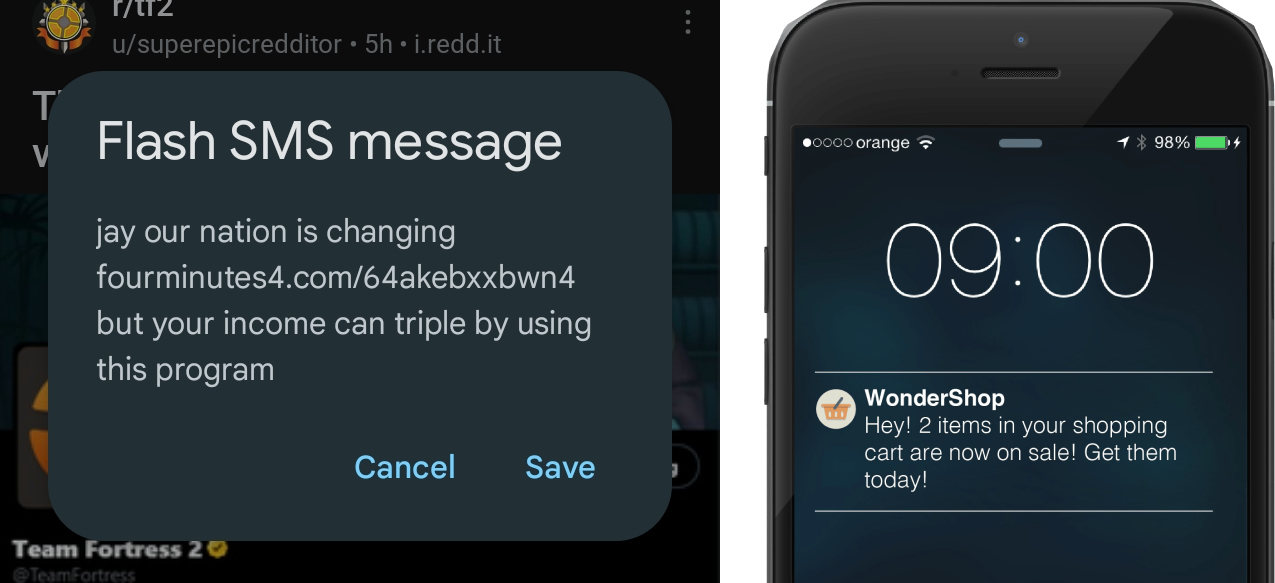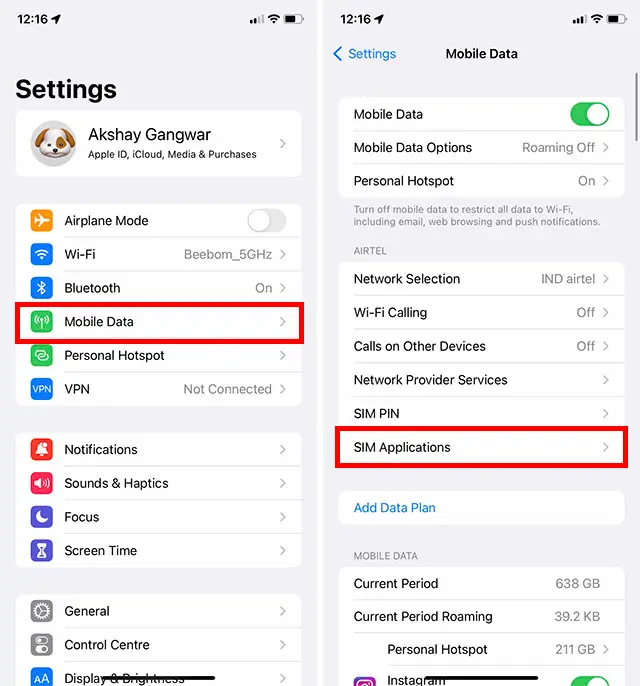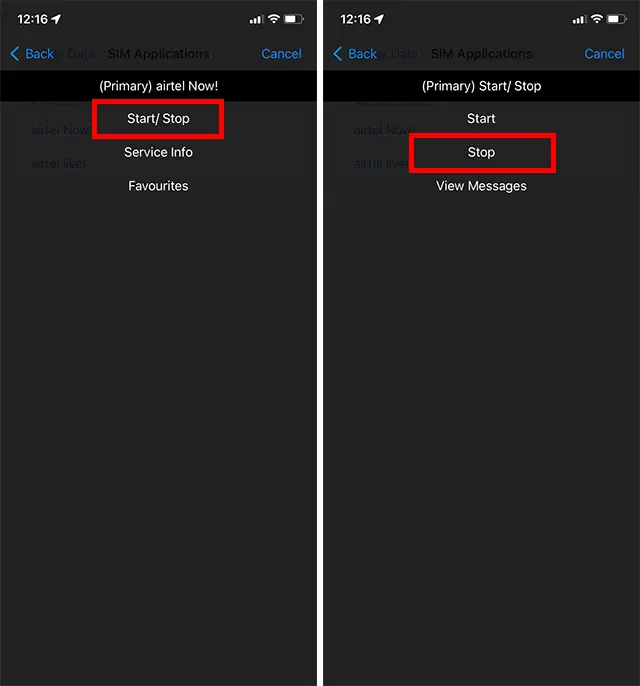
Flash SMS: How It Works and When to Use It
Flash SMS is a unique and powerful messaging tool for mobile phones that stands out from traditional SMS due to its immediate visibility and attention-grabbing nature. Unlike regular SMS, which is stored in the recipient’s inbox, a flash SMS message appears directly on the recipient’s screen, bypassing the inbox entirely. This feature makes it an excellent choice for urgent and time-sensitive communications, where immediate attention is crucial.
This article will explore the ins and outs of flash SMS, how it works, its unique characteristics compared to regular SMS, and when it's best to use this type of messaging. We'll also delve into how businesses can effectively integrate both flash text messages and SMS into their communication strategies.
What is a Flash SMS?

A flash SMS is a type of text message that appears directly on the recipient or sms provider's screen instead of being stored in their inbox. Unlike regular SMS, flash SMS messages are designed for immediate attention and typically do not save automatically on the recipient’s device. The recipient has the option to save the message if they deem it necessary or dismiss it without saving it. These messages are one-way communications, meaning the recipient cannot reply.
Flash SMS messages interrupt whatever is currently on the screen to display the message in front of the recipient, hence the name "flash." This feature ensures that the message is seen, regardless of which app is active on the mobile phone at the time.
Example Use Case: A bank might use flash SMS to send an urgent transaction alert that requires immediate attention or to notify a customer of potential fraudulent activity on their account. Similarly, government agencies could use flash text or SMS to send emergency alerts or warnings about natural disasters.
How Do Flash SMS Messages Work?

Flash SMS messages are transmitted using the standard SMS protocol but are delivered in a different format that forces immediate display on the recipient's screen. These messages are often short and concise, delivering essential information without requiring any further action from the recipient's phone. Typically, they are designed to be read in one go, with no need for scrolling, and they adhere to the standard SMS character limits.
When a flash SMS is sent, it bypasses the normal message inbox and pops up directly on the recipient’s screen. The message usually covers the entire screen, ensuring that it captures the recipient's full attention. After reading the message, the user can choose to dismiss it or save it, but they cannot respond.
Flash SMS vs. Push Notifications
While flash SMS and push notifications are both tools for delivering messages to the recipient's mobile phone or devices, they have distinct differences:
- Delivery Method: Flash SMS uses the SMS protocol and is delivered directly to the recipient’s screen, while push notifications are delivered via mobile apps.
- User Control: Flash SMS messages interrupt the user’s activity and display immediately, whereas push notifications appear in the notification bar and can be ignored or opened later.
- Use Cases: Flash SMS is used for urgent, time-sensitive messages that need immediate attention, while push notifications are better suited for non-urgent updates that encourage user engagement.

When to Use Flash SMS vs. Push Notifications:
-
Flash SMS: Ideal for emergency alerts, urgent notifications, and time-sensitive security messages where it’s crucial that the recipient sees the message immediately.
- Push Notifications: Better suited for promotional updates, reminders, and app-related notifications where user engagement is desired, but immediate action isn’t necessary.
Summary Table:
|
Feature |
Flash SMS |
Push Notifications |
|
Delivery Method |
SMS protocol |
Mobile app |
|
User Control |
Immediate display |
Notification bar |
|
Urgency |
High |
Varies |
|
Interaction |
One-way (no reply) |
Interactive (can open app) |
|
Ideal Use Case |
Emergency alerts, urgent messages |
App updates, promotional content |
The Advantages and Example Applications of Flash SMS Messaging
Flash SMS offers several benefits, particularly for urgent communications where immediate attention is required. Some of the key advantages include:
- Instantly Viewed: Flash SMS messages appear directly on the recipient's screen, ensuring they are seen immediately.
- Grabs Attention Quickly: The message interrupts whatever the recipient is doing, making it impossible to miss.
- Quick Action: The concise nature of flash SMS messages allows recipients to act quickly on the information provided.
- High Confidentiality: Since the message doesn’t automatically save on the device, it reduces the risk of sensitive information being stored or accessed later.
Specific Use Cases
Flash SMS also excels in various specific use cases, making it highly versatile for different industries. Here are some examples:
Urgent Alerts and Notifications
Ideal for sending emergency alerts, security warnings, or critical updates that need immediate attention.
Example: A government agency uses flash messages to send emergency weather warnings to residents in a specific area.
Marketing and Promotions:
Effective for time-sensitive offers or promotions that need to grab customers' attention instantly.
Example: A retail store sends a flash SMS message with a limited-time discount code during a flash sale.
Security and Authentication:
Flash SMS is commonly used in security protocols, such as sending one-time passwords (OTPs) or authentication codes that require immediate action.
Example: A bank sends a verification code via flash messages for a high-value transaction to ensure the recipient acts quickly.
How to Send a Flash SMS
Via Professional SMS Platforms
Businesses can send flash SMS messages using professional SMS platforms or mobile messaging services, such as DecisionTelecom’s SMS messaging service. These platforms provide the necessary infrastructure to send flash messages to multiple recipients simultaneously, ensuring that important notifications are delivered immediately.
Step-by-Step Instructions for Sending a Flash SMS:
1. Select a Service Provider: Start by choosing a reliable SMS platform that supports flash messaging. DecisionTelecom, for example, offers a powerful solution for businesses to send flash messages efficiently. Ensure the platform you choose provides global reach and good delivery rates for flash SMS.
2. Register and Set Up an Account: Sign up for an account and complete any necessary verification steps. Some platforms may require you to register a sender ID, which will be the name or number shown to recipients.
3. Compose Your Message: Write a clear and concise message. Flash SMS messages are typically short (within 160 characters), so make sure your message is direct and to the point.
4. Choose Flash SMS Option: In your SMS platform’s interface, select the option to send the message as a flash SMS.
5. Format and Preview the Message: Before sending, preview how the flash SMS will appear on the recipient’s phone.
6. Send the Message: Once you’re satisfied with the message, click ‘send’ or schedule the message for delivery if necessary. The recipient will see the flash SMS pop-up instantly on their screen.
Things to Consider:
- Costs: Flash SMS may incur different costs compared to regular SMS, as it provides more immediate visibility and urgency. The cost structure can vary depending on the provider, the volume of messages sent, and the recipient’s location.
- Target Audience: Flash SMS is best for urgent, time-sensitive messages like emergency alerts or security updates. Since it pops up directly on the recipient's screen, use it only when immediate attention is necessary. Overusing it for non-urgent updates can annoy your audience and reduce its impact.
- Content: Keep flash SMS short and to the point. With a 160-character limit, make sure the message is clear and actionable.
By taking these factors into account, you can maximize the effectiveness of flash messaging for critical communications while keeping your company's costs under control.
From Mobile Devices
Flash SMS can also be sent directly from mobile devices, though the process varies between Android and iOS.
Android Devices:
To send a flash SMS from an Android device, you'll need to install a special SMS app that supports this feature. Here's a step-by-step guide:
1. Download a Flash SMS App: Go to the Google Play Store and install an app that supports flash SMS, such as "Pansi SMS" or "Handcent SMS."
2. Compose Message: Open the app, create your flash message, and ensure you select the flash SMS option before sending. This option is typically found in the message settings or as a checkbox.
3. Send: Review the message to ensure it's formatted correctly, then send it. The recipient will see it pop up immediately on their screen.
iOS Devices:
Unfortunately, iOS doesn’t natively support sending flash SMS, and most apps that attempt to offer this functionality are restricted by Apple’s guidelines. As a result, users on iOS devices must rely on external SMS platforms, such as DecisionTelecom, to send flash SMS messages.
Flash SMS as Part of Communication Strategies
Flash SMS can be effectively integrated into a broader communication strategy, especially for businesses needing to reach customers quickly and reliably. Industries such as finance, healthcare, and retail often employ flash SMS for various purposes, including security alerts, urgent updates, and promotional campaigns.
Here are some examples of how various sectors can utilize it:
- Finance: Banks and financial institutions frequently use flash SMS for security purposes, such as sending one-time passwords (OTPs) for transaction verification or alerting customers about suspicious activity on their accounts.
- Healthcare: Medical facilities and healthcare providers can use flash SMS to send appointment reminders, urgent health alerts, or critical test results.
- Emergency Services: Governments and emergency response organizations use flash SMS to communicate critical safety information. This could include weather warnings, evacuation orders, or public health advisories, ensuring citizens receive the information immediately.
By integrating flash SMS into their communication strategies, businesses across various industries can ensure their most important messages are seen instantly and acted upon quickly, providing a reliable method for urgent communication.
Challenges and Limitations with Flash Texts
Like any communication tool, flash SMS comes with its own limitations. While it’s great for urgent, time-sensitive messages, there are several aspects businesses need to consider for effective use.
Technical Issues
Flash SMS may not work smoothly on all devices or networks, causing inconsistencies in delivery. Some older phones or network providers may not fully support this feature, leading to missed or delayed messages.
User Experience
Flash SMS, when overused, can feel intrusive and annoy recipients, especially if the messages aren't truly urgent. Businesses need to carefully balance the need for immediate communication with the user experience to avoid frustration and message fatigue.
Privacy/Legal Concerns
Sending flash SMS requires strict adherence to privacy laws. Businesses must obtain explicit consent from recipients and ensure they comply with regulations like GDPR or TCPA. Failure to do so can result in legal consequences and damage to customer trust.
How to Stop Flash SMS Messages on iPhone and Android

Please follow this instruction to disable flash SMS messages on your phone.
On Android:
1. Open the Messages App: Go to the settings.
2. Disable Flash SMS: Find the option for Flash SMS or Class 0 SMS and turn it off.
On iPhone:
1. Open Settings: Navigate to the messages settings.

2. Contact Your Carrier: If flash SMS is still active, you may need to contact your carrier to disable it.

Conclusion
Flash SMS is a powerful tool for delivering urgent, time-sensitive communication directly to your audience. Its ability to ensure immediate visibility makes it ideal for emergency alerts, security updates, and critical notifications. However, like any tool, it comes with limitations, including potential technical issues and the risk of overwhelming users if overused. When thoughtfully integrated into your communication strategy, flash SMS can be an invaluable asset for businesses that need to reach customers quickly and reliably.
Looking to implement flash SMS for your business? Reach out to DecisionTelecom for a reliable and flexible bulk SMS messaging service that can be tailored to your specific needs. Their platform ensures seamless and timely delivery of your messages, providing you with the tools to communicate efficiently.


